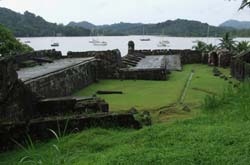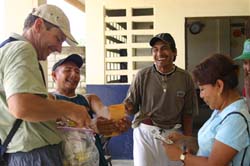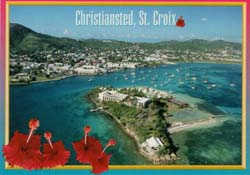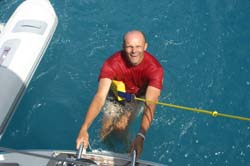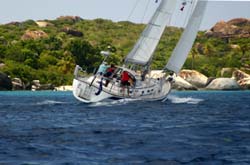Leg 4, Update 1 SAFELY THROUGH THE CANAL! May 17, 2006, 1630 hrs., 09.21N, 079.54 W, Log: 100,890 miles, on the dock of Panama Yacht Club, Colon, Panama Baro: 1008.8, Calm winds, drizzle. Cabin: 80F, Cockpit Temp: 82F, Occasional drizzle
What an incredible day! We were told by the canal scheduler to be standing by at 0700 in front
 Thomas and Carlos, our canal advisors, with a morning coffee |
of their Flamenco Signal Station (the control tower for the Pacific entrance of the canal, located on the same island as Flamenco Marina) at 0700. We had set our alarms for 0530, planning to get underway at 0600. At 0615 we were about to give up on Ricardo, the line handler recommended by Tina McBride, our agent, when he showed up. We cast off, motored slowly around the island, and let Flamenco Signal know we were on station; waiting for our Pilot Advisor to board. We were told the boarding time would be 0700, then 0745 so we circled around eating breakfast and listening to the canal radio traffic.
Belle Flora, a merchant ship of some type, called on the radio to confirm their pilot time as 7:30. Another vessel identifying as US Navy warship 43 also called to confirm their pilot boarding time as 7:30. Flamenco Control advised the warship she was scheduled to transit the following day not today. The warship replied that is not what their agent had told them. They did not sound happy at all. Within 20 minutes phone calls must have been made as Belle Flora was radioed back and told they wouldn’t be transiting until the following day. They had been bumped for the warship.
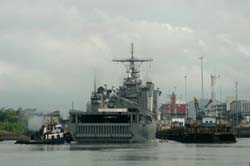 Warship 43 being positioned into the lock |
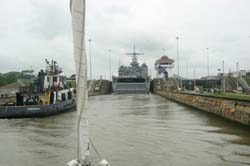 Entering the lock to side tie to the tug |
At 0815 the pilot launch came alongside and delivered Carlos, a full canal pilot and Thomas, a pilot advisor in training. “Full speed for Miraflores Lock!” was their simultaneous greeting. As we opened the throttle to make eight knots against current M.T spewed black smoke, her engine temperature climbed and our advisors looked a little pissed. We were to be locking up with the warship 43, Fort McHenry at 0900 so had to push hard to make it for best of all lock situations: side-tied to Esparanza, an ACP tug assigned to maneuver the warship.
Thomas, our training advisor, normally operats one of the two large canal dredges with a crew of 18 men. He had volunteered to be trained as a relief advisor for yachts. He explained that with up to a one month wait for yachts to transit during the peak month of March, the ACP (Autoridad del Canal de Panama) didn’t want to hire full time advisors and have nothing for them to do nine months a year. The solution they choose is to train existing personnel who can volunteer for overtime to serve as advisors on their days off during the months of peak demand. Carlos was a full pilot and was training and evaluating Thomas.
We did a lot of waiting as the warship was very slowly and carefully maneuvered into each lock before being hooked up to the electric locomotives. When it stared to drizzle, both of the guys removed their shoes and socks and tucked them under the dodger so they wouldn’t get wet. Thomas pulled out a plastic rain jacket and pants while Carlos preferred to sit under the dodger reading the paper. The last time we had transited our advisor had been unhappy that we didn’t have any junk food and Coke. This time we were prepared with Coke and candy bars. Amanda even researched Panamanian dishes on the internet to make sure they would be happy with lunch. We’ve heard stories of advisors ordering out for restaurant lunches to be delivered to them as they were unsatisfied with the lunch provided on the yachts, and charges of up to $200 for this service subtracted from the yacht’s buffer fee. Amanda made Panamanian rice and beans with tasty roasted chicken. But as it turned out, Thomas was a vegetarian and loved the spread of fresh fruit and vegetables as well as our last night’s reheated pizza.
After Pedro Miguel lock Thomas informed us that we would probably have to spend the night tied to a mooring in Gatun Lake as our transit had been slowed by the warship. No one said anything, but when we approached Banana Passage, a shortcut through the mangroves that yachts occasionally are directed to take, he said that if we could make it to Gatun locks by 1700, we might be able to lock through Gatun that evening. I asked if we could take the shortcut, he said “Sure”, so we poured the power on and kept a lookout for howler monkeys and toucans as we barreled through the narrow passage flanked by overhanging trees.
As we approached Gatun the lock control told him we needed to wait for 45 minutes, so Thomas instructed us to side-tie to a huge foam-encased mooring buoy. Ricardo, our linehandler had done
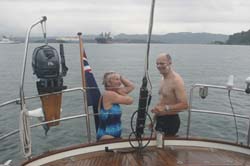 Laura and Peter soap up for swimming |
this many times, prepared bow and stern lines and jumped aboard the large buoy to secure us.
In minutes most of us dove into the freshwater lake while keeping an eye open for the notorious HUGE crocodiles that live in the lake. Ricardo told us of a fisherman who had been dragged away and eaten by a croc not too far away, but that swim sure felt great!
Side-tied to a similar mooring nearby was Hebe, a Golden Gate 30 sloop from San Francisco. Newlyweds Ariel Pavlick and Tim McFadden and their crew of four yachtie linehandlers had been waiting 24 hours for another advisor so they could complete the final set of locks. Thomas called the control station and just as we were getting underway a launch showed up with three advisors for Hebe! There was a great amount of banter and laughter back and forth, and the advisors in training said they all wanted to come on Mahina Tiare as there was more room.
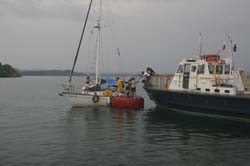 Hebe receiving her three advisors |
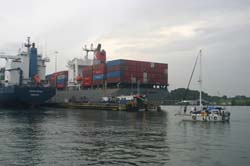 Hebe approaching the lock |
We motored together to the entrance of Gatun locks, waited for awhile as a ship hooked up, then Thomas instructed Hebe to raft alongside us on the starboard quarter. We were to slide ahead under the bow of the ship into the chamber. Maneuvering with Hebe alongside wasn’t difficult until we got to the end of the lock and tried to stop. Thomas explained we would have only one
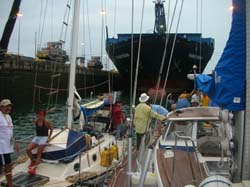 Rafted with hebe |
chance to get the port stern line on the tug. If we missed it, the 1.1 knot current would plaster us against the gates of the lock. As I approached, Lynn got the stern line to the tug, but when I tried to slow, Hebe kept moving forward, pivoting our bow toward the tug. Strong hands, seven tires plus three fenders did the job.
Leaving the lock was even more difficult as we were instructed to motor slightly away from the tug, allowing them to move forward before following them to side-tie again. Unfortunately the tug surged forward, with their wake pushing us sideways in the lock and very close to the wall. Despite my working the throttle and wheel to the max, Hebe, on the outside came within 3′ of scraping the lock wall. It was very intense.
We repeated this another time, now in the dark, then we were out. The final lock opening is the
 Nght time in the lock |
most difficult as the freshwater mixing with the incoming seawater produces a lot of turbulence. I asked Thomas if Hebe could cast off first, followed by MT and then the tug, but he said we needed to go together, and asked for full power. We made it out safely, cast Hebe off, and headed to “The Flats”, the designated anchoring area for yachts off the Panama Yacht Club. It was dark and raining, but the pilot launch found us, we said goodbyes, and headed toward the club.
Earlier I had called the yacht club, only to be told there was no space and no possibility of rafting. Ricardo said, “There is always space, even if we have to tie up to the gas dock”. He faced a long bus ride back to Panama City carrying our four heavy 7/8″ x 125′ dock lines that we had borrowed from Tina, and didn’t relish the thought of a wet dinghy ride across the flats.
Sure enough, he was right! There was one berth available, an end-tie perfect for Mahina Tiare. Minutes after we tied a guy from the club said that for $30 we could stay the night there and told us the club’s Chinese restaurant was still serving dinner for another half hour, so we were set.
The next morning we piled our 16 plastic-bag wrapped tire fenders on shore and a few minutes later on the VHF morning cruisers net someone mentioned that there was a large pile of tires available. In minutes they were all gone!
A FEW PRACTICAL NOTES FOR TRANSITING THE PANAMA CANAL:
There is an excellent new book, “The Panama Cruising Guide” , ISBN 9962-02-829-9 by Eric Bauhaus, ebaauhaus@gmail.com, www.sailorsnet.com. Eric did a phenomenal job with the book, and it is a necessity for cruisers coming to Panama.
Although it isn’t necessary to hire a professional linehandler (most cruisers help each other to ensure four linehandlers aboard each yacht, excluding the skipper), we think that at $65 it is a small investment in damage prevention. Ricardo came highly recommended by Tina McBride, our canal agent, and was extremely helpful at knowing exactly which line needed to go where and when, plus he stayed focused through the long day.
Sometimes the shoreside canal linehandlers release the yacht’s lines too early or the tug guys are little lax in securing a yachts line. Having an experienced linehandler aboard who knows “everyone” and can speak fast direct Spanish is an asset. Ricardo was also able to answer all the zillions of small questions we didn’t want to bug our advisor with all day.
It also isn’t necessary to hire an agent, as some of the taxi drivers can show you which offices need to be visited in which order, but at times (February and March) when the waiting list for a transit date reaches one month, it can certainly speed up the process. Tina McBride’s website has a form with all the questions needed to be answered, she can handle all payments and refunds and arrange for cruising permits, signing crew off and on and generally make a transit as easy and fast as possible. Her fee is approximately $550. At peak times like February – April, she can have a yacht get admeasured an on the scheduling list, then take off for weeks cruising the San Blas Islands instead of waiting in the not-so-nice and very crowded Colon area. She stays in daily contact with the scheduling office and can let her clients know when to start heading back toward Colon for their transit.
The two agents we recommend are:
Tina McBride, www.panamacanaltransits.com, email: tinamc@sinfo.net, or tinamcbride@hotmail.com
Peter Stevens, delfinomaritime@hotmail.com, delfinomaritime@bellsouth.net.pa, 011-502-261-1931, fax 507-261-3236, cell: 507-613-1134.
Other useful information and sites:
Panama Canal Authority (ACP) website: www.pancanal.com
Balboa Yacht Club: moorings for $0.40 per foot per day includes launch service and wi-fi: bycbilling@cwpanama.net
Flamenco Marina: marina berths (some with power) for $1.60 per foot per night, 200 ton travel lift: Docks are funky and surge can be a problem. www.fuerteamador.com
Panama Canal Yacht Club (in Colon) may have slips available for $0.50 per foot per night. Showers, Chinese restaurant, laundery, internet and a wild bar like out of Star Wars! email: pcyachtclub@cwpanama.net
Shelter Bay Marina is a new and nearly completed marina at the old US Ft.
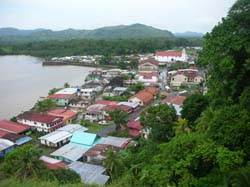 The town of Portobleo |
Sherman base, about a 40 minute taxi ride from Colon. Although somewhat isolated, we heard rave reviews about Shelter Bay, and the moorage rates are less expensive than Flamenco.
Our 20 mile passage to Portobello was in large, sloppy swells, but no wind. The sea was chocolate brown and large trees and all types of junk floated by, a result of the recent heavy rains. There is no dry season on the Colon side of the Canal, unlike on the Pacific side, although skies cleared nicely as we approached Portobello. Instead of the three or four yachts we had seen in our two earlier visits to this historic bay, we counted over 20 yachts, and several looked like they hadn’t done much sailing in several years.
Christopher Columbus arrived in Portobelo in 1502 and in 1597 the Spanish established a city here. The riches of the Orient, as well as those taken from Mexico, Central and South America
 The counting house
|
all passed through Portobelo on their way back to Spain. There was a mule train path, the Camino Real, across the isthmus to Portobelo and it didn’t take long before Drake, Morgan and an assortment of pirates started attacking the town.
The resulting two forts, one at the entrance, the other along the foreshore of the town are impressive. Spain has been funding their reconstruction and the counting house where all the treasures were tallied has been turned into a museum. We enjoyed exploring this crazy little end-of-the-road frontier town. Brightly painted old US school busses make the 45 minute trip to Colon every hour and we were surprised to see Panamanian families enjoying a little holiday on the long weekend. Obviously they had taken the bus from Colon or Panama City and were enjoying looking around. We didn’t see a single gringo, but have heard there are a few yachties who have moved ashore here.
We anchored off Fortress San Fernando opposite the town, hiking up for some great views before sunset.
With over 50 miles to the first anchorage in the San Blas Islands, we raised anchor in the early morning light and were pleased with a 1.5 – 2 kt following current that speeded us on way. Our
 Approaching sailing canoe |
intended anchorage has a very challenging and narrow anchorage with little chart detail available, so we were pleased to arrive in good light. Tilly Whim, a yacht from the Virgin Islands had given us a hand-drawn sketch and recommended the anchorage when we met them at Pedro Miguel Boat Club in 2000. Amanda had made a special friend of Adelia, a woman who lived on nearby Chichime Island, and was hoping to see her again.
Soon after we anchored cayukos, or sailing dugout canoes headed our way. The first was a young family who had seven months earlier moved to a totally new island astern of us that they had started building. Julio explained that they were tired of the busy village life and just started digging up coral and sand by hand and piling it up. They had two thatch huts built on coral and sand island and he said in six years they would have a nice island, complete with coconut palms
Another family is always assigned by the sayla (village chief) to live for six months on Yansadur, an island of
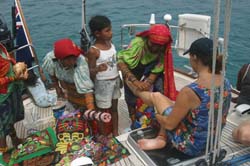 Kuna’s selling molas and beads |
a couple acres that is the closest to the anchorage. They also visited unloading dozens of colorful molas from five gallon plastic pails. We all bought several molas from each of the two families, as we were anchored in their waters, and accepted their invitations to visit.
On Monday it REALLY rained, so we focused on navigation, diesel engine maintenance and I worked on repairing a selector valve on the watermaker plus a leak in the hot water tank.
Tuesday we covered marine weather, Amanda and I both went up the mast (separately) and Amanda managed to free the sticking main halyard sheave whose bushing has become worn, then we raised anchor, stopping briefly at Chichime to find that Adelia no longer lives there. We also anchored briefly off Banedub island to visit Justino Galindo, a clever guy who kept sailing over in his
 Baking Kuna bread |
very nifty sailing canoe to visit and practice speaking English. Justino asked for any English newspapers of magazines and we wished we had an extra Spanish-English dictionary as he hopes to become a guide for yachties. He and his cousin share the small island where his cousin has a tiny store and bakes hot “kuna bread” every hour, all day! We didn’t really believe this until we saw his propane stove in operation producing rolls. We bought 30, fresh out of the oven although they didn’t all make it back to the boat.
Our evening anchorage was at Gaigar, a mangrove-protected bay (also shown us by Tilly Whim) not too far from Mormake Tupo, an island we have brought school supplies to on our previous visits. Being surrounded by tropical rainforest jungle on two sides, hearing howler monkeys and tropical birds and watching a new moon rise over the water was incredible.
Ross:
Tues. May 31: We slowly approached Mormake Tupa with two people forward on lookout for the reefs and scattered shoals surrounding the island. Seeing the island was to be transported to another time, another world. Thatch huts ringed the shoreline, each hut seemingly an extension of the
 The Restepo family compound |
next. From the middle of the island palm and banana trees sprouted. Life abounded from these Kuna shores – children laughing and playing, people coming in anticipation to the water’s edge and dugout canoes busily sailing to and from the island.
We anchored off the island in front to the Restrepo family compound where John and Amanda had previously been given an introduction (and gifts to take) to this family by Tom and Maureen on Tilly Whim. This was their third visit and Venacio, the main English speaking person in the family and also a master mola maker, had earlier stopped by our first anchorage and welcomed us to revisit his family and island.
We tied the dinghy at the family compound coral wall. Two pigs in pens overhanging the water grunted and children smiled shyly. An elderly Kuna women detailed in Spanish what we saw; the bathroom hut perched over the water, the family house with laundry drying and a large dugout canoe in progress.
Venacio took us straight to the school where we delivered school supplies to the headmaster. The school was having a special fiesta with lots of races and competition in the main courtyard as celebration of an international “No Smoking” day. When the headmaster asked for something with the boat name and email address, he looked at the boat notecard that has a drawing of MT on it and suddenly remembered their previous visit. His big smile said it all, the supplies were much appreciated. He said school supplies of any kind (paper, blank lesson books, pens, pencils, construction paper, scissors, glue, etc) would always be a tremendous help and we promised to get the word out to other yachties, so if you are reading this and planning on sailing your own boat to the San Blas, please do your part. The anchorage off Venacio Restrepo’s house (next door to the school) is: 09 27.180 N, 078 51.200 W.
 John and Ross chatting with the headmaster |
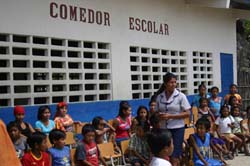 School teaching instructing students |
Next, we met the present sayla, or chief, and asked for permission to enter the village. The congresso, or village meeting house is always the largest thatch structure, and generally one or
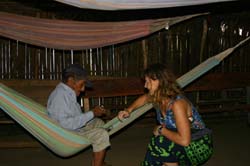 Amanda giving glasses to the sayla |
more of the chiefs stay there reclining in hammocks, often smoking pipes. Venacio introduced us individually to the sayla who was small, friendly and proudly 80 years old. Amanda presented the requisite small bags of rice and sugar, the traditional gifts, plus a magazine and John gave the $5 anchoring fee. I gave a gift of a Gas Café, Eat Here, Get Gas! T-shirt from my brothers’ restaurant-gas station in Colorado which also delighted the chief.
We were then free to visit the village, following Venacio, not just wandering around by ourselves. Venacio had told the women that there would be eight of us visiting and the women had hung molas on the outside bamboo walls of their houses. Nearly all of the women wore traditional Kuna dress, a colourful ensemble of mola blouse, printed wraps, wini beads, red head scarf and faces adorned with a black nose strip, gold nose ring and ruby cheeks. What a busy time! We wove our way through an intrigue maze of thatch, going from hut to hut to meet the women and study their legendary molas, beautiful appliqué designs of animals, insects, lore and patterns.
 Kuna women in traditional dress |
 Traditional dress |
Well behaved children huddled at the legs of their mothers and smiled, small dogs wandered about, little green parrots were paraded by their owners and smoke from their kitchen fires lazily drifted in the air. Amanda passed reading glasses out to several of the older women who
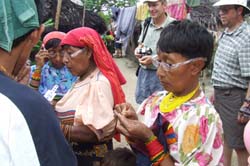 Kuna women testing eyeglasses
|
were quick to try threading a needle to see which glasses strength worked best. Lore said one women nearly started crying, saying that her eyesight hadn’t allowed her to sew molas recently but now with glasses she could earn a living again.
Our last stop was Venacio’s family home where one of his sister’s was making a wini; a beaded leg or arm wrapping. His others sister quietly showed off their exquisite molas and Venacio’s 79 year old father was busy weaving an intricate basket. This is a family of artists!
After saying goodbye, we motored two miles away to the island of Rio Sidra to find the clinic. On the way through the village, the man who was leading us took us by the very busy school, introducing us to the six teachers (for 290 children). When we said we were looking for the clinic so we could donate the reading glasses, nearly all of the teachers lit up, and they had a lot of fun trying to read with the different strengths of glasses before finding a pair that worked for them.
We did find a very tidy-looking clinic and donated the bulk of the glasses to Hector, who worked there. We have a big thanks to Skip Crilly, of our Leg 3 crew who purchased several hundred pairs of glasses from a couple of different close out wholesalers he found on the internet. Another special thanks goes to Lori Abrahams-Dana from Leg 2 who also gave a generous donation that enabled us to purchase school supplies.
While we had been at the clinic a 50′ funky wooden Columbian trading boat arrived, docked and we were invited aboard to shop. They had excellent onions, cabbage, potatoes, rice, flour and
 Anchored off Rio Sidra
|
cocaine for sale. This is how the Kunas shop, and the Columbians buy coconuts in return. It’s hard to understand how it could make sense for the Columbians to purchase unhusked coconuts, but until three years ago coconuts were the prime trading currency of the San Blas islands. Now the US dollar is the currency of choice.
Amanda picked up some good looking cabbage and onions and we found some more hot kuna bread, then set sail for Holandes Cays. We had an excellent broad reach, stopping so that everyone could practice our nifty new Lifesling rescue technique, before anchoring and jumping in for a swim.
That brings us up to date. It is now Thursday, June 01, 2006 and we have a very good forecast for our passage to the Dominican Republic or Puerto Rico. Commanders Weather, the NMG weatherfaxes from New Orleans and the GRIB files all are predicting moderate E and occasionally ESE trades of 10-20 knots, much mellower than the average NE 20-30 kt winds we experienced in 2000.
June 2, 2006, 1100 hrs., 10.33N, 075.58 W, Log: 101,122 miles, 40 mi N of Cartagena, Columbia
Baro: 1011.2, Motorsailing in 7 kt. W winds. Cabin: 85F, Cockpit Temp: 84F, overcast
We set sail from the San Blas yesterday noon with light winds and lumpy seas. Last night the winds filled in from the SW averaging 16-20, but with 1.5 – 3 kt following current, our speed over the ground reached 11 knots several times. Today the wind has swung around to the W, so we
 Donating the eyeglasses to the clinic |
just gybed and are now on a course to a waypoint 20 miles N. of Baranquilla, Columbia. We have no intention of stopping, but every mile we get of easting, now when broad reaching, means a better wind angle the rest of the passage which will be close-hauled against the current. Lynn set a waypoint this morning for the very southern tip of the Domincan Republic, and according to the GRIB files, we should be able to lay that course, at least for the first day or so.
Here’s our Leg 4 crew:
Ross Tunkey, 31 from Crested Butte, Colorado
I grew up in the tropics of South Florida and for years I have dreamed of voyaging by sailboat. I have daysailing and limited coastal cruising experience so far. I now live high in the Rocky Mountains, but the cruising dream is still with me. Mahina Expeditions offers the perfect opportunity to test my dream with offshore cruising reality, gain skills and discover how I want to pursue the dream further.
Michael Perello, 41
My boat will be called Insatiable Curiosity and that best encapsulates the voraciousness I’ve pursued in all aspects of life. The ability to not only sail, but live aboard a boat and circumnavigate the globe serves as both the method and means to my core pursuit. So I’ve come to learn from the best such things and will be aboard until we reach the Azores.
Peter Verstoep, 44
I live in Steinbach, Manitoba, Canada with my wife Debbie and our two sons, age 6 & 8. We have sold our hotel business and I am taking this expedition as a starting point for our family circumnavigation. I wanted to learn all aspects of successful cruising as we will be buying a boat once I complete this expedition and I already have several lined up in Ft. Lauderdale to look at. It has given me the insight in what is needed in a boat, equipment and procedures we should abide by to explore the world with my family in safety.
Lynn Zeidler, 49
I’m from Calgary, Alberta and I grew up sailing, racing and teaching in dinghies. Seven years ago we started training in cruising boats 38-42′ in the BVI’s and West Coast’s Gulf Islands and San Juans. Together with my husband…
Stephen Dorsay, 50
We commissioned a new Outbound 44, New Latitudes, in 2005 and are now looking forward to more sailing on the West Coast in the next few years, followed by an offshore cruise, possibly to the South Pacific.
Lore Haack-Voersmann, 52
This is the third time I’ve joined Mahina Tiare. The first time was in 2001 when we sailed from Panama to Hilo, and last year in Alaska. The last 20 years I sailed on different ships from big square riggers to small sloops everywhere in the world. But now it becomes more and more my dream to do all this with my own little boat named Orion, a 12.2 meter Vilm II. I sometimes sail Orion with my four children and wonderful husband, Peter, and sometimes singlehanded. Next year I plan to sail from my homeport in Germany to Norway to meet Amanda and John.
June 6, 2006, 1330 hrs., 17.34N, 068.14 W, Log: 101,721 miles, 95 miles WSW of Ponce, Puerto Rico Baro: 1008.8, Winds SE @ 21 kts, Seas 6′-10′, confused. Cabin: 88F, Cockpit Temp: 91F, Clear skies
An Unforgettable Passage to Windward
We left the San Blas Islands on Thursday, June 1st and were surprised with a 2-3 kt following west-setting current and light variable winds until Saturday noon when we were nearly to the Columbia-Venezuelan border. Our original plan was to sail or motorsail on a compass course of 25 degrees 20-30 miles off the Columbian coast to the vicinity of Cartagena, then set a course north toward Haiti and the Dominican Republic. But when we zoomed past Cartagena, we decided to continue gaining valuable easting on a course of 45 degrees for as long as possible. We motor sailed to nearly to the northernmost point of South America and the Venezuelan border until 15-17 kt easterlies made the going slow and wet so we decided to shut down the engine, unrolled the jib and set sail on 70 degrees for Ponce, Puerto Rico 230 miles away.
Instead of the average 20-30kt NE winds, we have had ESE to SE winds of 15-25, with only occasional gusts higher. The real bonus is that instead of making landfall south of Haiti, we are now 32 miles south of Mona Island, in the middle of the Mona Passage between Puerto Rico and the Dominican Republic, and we still haven’t tacked or motor sailed yet! With 95 miles to go to the entrance of Ponce, Puerto Rico, we look forward; weather permitting to arriving tomorrow morning.
We are now picking up NOAA weather radio forecasts from Puerto Rico and they are calling for E 5-15kt winds tonight, so we will sail as far as we can, then probably motorsail close inshore along the coast until dawn.
Our Leg 4 crew signed up for heavy weather experience, and they have all done incredibly well. Aside from a quick spit early on, seasickness has not been a problem even though conditions have been very rough. For the first time in a long time, everyone on board is taking staying hydrated
 Lore and Lynn shake a reef |
seriously, so we don’t have any sleepyheads. When we call for a reef to be set or shaken out, we have more volunteers than we know what to do with. We have rarely had less than two reefs in, and several times, including now, have had three reefs in – not so much for the wind speed, but just to keep the boat speed down so MT doesn’t go careening off the top of a swell, only to crash into the trough seconds later.
June 15, 2006, 1130 hrs, 18.30 N, 064.22 W, Log: 102,051 miles, at anchor Prickly Pear Island, Virgin Gorda Sound, British Virgin Islands. Baro: 1016.0, Winds E @ 11kts, Cockpit Temp: 90F, Cabin Temp: 85F, Tradewind skies!
We held our one tack all the way from the Columbian coast to Mona Island, in Mona Passage, just off the SW tip of Puerto Rico. At 0200 we made our first and only tack to clear Punta Melones, and by 1120 hours we were tied up at the Ponce Yacht Club’s fuel dock waiting for US Customs. Customs was a breeze and we signed off Michael who succumbed to the call of business vs. sailing. Peter asked if he could invite his wife Debbie to fill the empty berth, which we agreed to.
Ponce Yacht Club has expanded their moorage and had a slip available for us. Peter rented a car
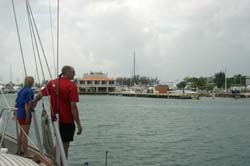 Arriving at Ponce Yacht Club |
to drive across Puerto Rico to pick up Debbie at San Juan Airport and kindly took us for a serious provisioning run to Sam’s Club before taking crew on a tour of Ponce.
Since we were five days ahead of schedule we decided to break up the 135 mile passage to windward to St. Croix with a couple of stops. Our first overnight anchorage was off Salinas – but we didn’t go ashore as we set sail very early (0330) before the tradewinds started cranking on the 55 miles passage to Isla Vieques. Vieques has been a bombing range until three years ago,
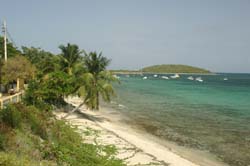 The beachfront at Esperanza
|
but the US Navy left and now there are new parks on either end of the island. We found a protected anchorage and the lovely little town of Esperanza which we explored Saturday afternoon. There were lots of local families enjoying cooling off in the shallows at the beach and everyone was very friendly.
Sunday morning we got another early start so that we arrived at Christiansted, St. Croix, USVI by 1130. With most of the cruising boats headed out of the area for the start of hurricane season, we found plenty of dock space.
Our intrepid crew commandeered a taxi and circumnavigated the island, stopping to enjoy sunset. Our Volvo shaft seal which I had just replaced in March had started leaking a month ago, and by this time was passing a steady stream of water, no longer just a drip. Normally these simple and reliable seals last 40,000 miles, but this must have had a faulty lip seal. When I asked the marina manager if they could haul us part way out of the water for an hour, he said, “Let’s go now!” This was at 0730, and was not the answer I expected – what about laid back island time? Our crew scarffed down breakfast as we dropped the headsail and forestay and got MT into the Travelift bay. The lift wasn’t working properly, but eventually Washington, the operator got us three feet out of the water so I could change out the shaft seal. That went flawlessly and before long we had everything back together.
Ross discovered that Cruzan Rum, a company whose CEO was a long-time family friend was located on St. Croix, so he called his best friends dad in Miami and organized a VIP tour of the distillery.
We had been tracking an active tropical wave weather system for several days, and decided to make the 40 mile passage during the frontal passage. By the time we cleared St. Croix the wind
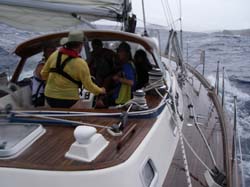 Arriving in BVI’s in 45 knots |
was already gusting in the mid 20’s so we hoisted the main with two reefs, but before long we had a huge squall, more than 15 miles across bear down on us. With three reefs in the main and headsail and wind gusting into the mid-40’s, we had quite a challenging crossing. Just as we neared Norman Island another squall hit, also with gusts in the 40’s. We heard several Mayday’s on Channel 16 but once we were in the lee of Norman and Peter Islands the seas smoothed right out.
Little Harbor on Peter Island, just across from Road Town, Tortola was our destination. Winds gusted to 46 knots as we motorsailed the last few miles into Little Harbor where we found good protection. The williwaws caused the four boats already anchored in the bay to dance in every direction, so once we were anchored, Ross and Lynn swam a stern line ashore and we moored Med-style to a small tree. This worked very well and kept us out of the middle of the bay where charter boats merrily bump into each other in the night. We enjoyed some good snorkeling before a huge downpour passed by and thankfully washed all the salt off MT.
Yesterday we had a vigorous beat to windward to clear customs in Spanish Town, Virgin Gorda. The marina provided one hour free moorage for customs clearance, and we enjoyed looking around at the boatyard, shops and buying ice cream cones. Spanish Town looked a busy place, so we set sail north, arriving at Prickly Pear Island in Virgin Gorda Sound well before dark. This anchorage was Lynn and Steve’s suggestion, and proved perfect! Here we are, off a quiet, uninhabited island, well protected from the still-gusty winds, but out of the busy mooring fields off Bitter End Yacht Club, just a mile away.
This morning Amanda has been really focused on teaching rigging, with deck rig check, everyone going aloft to check the mast and rig, and rigging spares. Now she is teaching how to macramé pull lanyards on snap shackles. After lunch we are going to set sail to practice live, in-the-water Lifesling Rescue as Peter has volunteered to jump in the water. We would also like to explore Gorda Sound, and what better way is there than under sail!
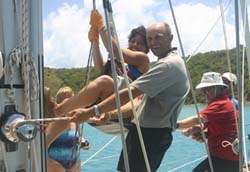 Debbie takes to new heights
|
June 17, 2006, 0930 hrs, 18.26 N, 064.39 W, Log: 102,082 miles, at anchor in Brewer’s Bay, Tortola, British Virgin Islands. Baro: 1016.0, Winds E @ 11kts, Cockpit Temp: 90F, Cabin Temp: 85F, tropical wave approaching
We had a blast tacking around Gorda Sound as Amanda shot images of Mahina Tiare charging along. Dinner was ashore on Saba Rock, www.sabarock.com, a tiny man-made island and early yesterday morning we set sail for The Baths, a famous spot at the south end of Virgin Gorda. Here giant boulders abound on white sand beaches forming caves, amazing snorkeling and great hiking trails. Since we were only the second boat on the day moorings (anchoring is not allowed in order to protect the coral) we had the place to ourselves. Nowhere have we seen such an amazing place! At the end of the hike we found a very attractive restaurant with an absolute killer view called Top of the Baths.
Amanda volunteered for more photo duty in the dinghy and we spent more than an hour, tacking back and forth in front of the incredible backdrop of The Baths before setting sail for Tortola, passing Beef Island, going through some narrow channels (all under sail!) and stopping for a great snorkel off Monkey Point.
When we read that bareboat charter boats aren’t allowed in Brewer’s Bay, and that there was minimal development ashore (just Nicole’s Beach Bar which was closed), we were hooked! We found an incredible bay, a safe anchorage with a sandy bottom and all enjoyed a great sunset walk on the beach in the calm evening. The only boat in the bay is a cruising tri with a couple families onboard. What a change from anchorages packed with of charter boats!
This morning Amanda is covering sail making and repair, and this afternoon we are going to set sail for Jost Van Dyke, where our crew have read about several “must see” places in the new, first-class cruising guide, Exploring the Virgin Islands by Mark Bunzel and Joe Russell at www.FineEdge.com.
June 18, 2006, 2200 hrs, 18.25 N, 064.37 W, Log: 102,105 miles, at Village Cay Marina, Tortola, British Virgin Islands. Baro: 1016.0, Winds E @ 11kts, Cockpit Temp: 80F, Cabin Temp: 85F, tropical wave passing with occasional rain storms.
We’re HERE! Yes, we just completed a very successful Leg 4, Panama to Tortola and a few hours ago we tied up in the same tidy marina, Village Cay, that we used in 2000.
We had a rip-snorter of a sail from Brewer’s Bay, Tortola across to Sandy Cay (too windy and
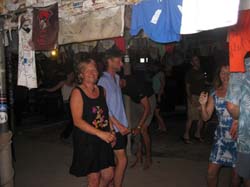 Lore, Ross and Amanda on the dance floor |
exposed to stop for lunch), Little Harbor (a nice lunch stop) and then Great Harbor where we spent the night at anchor.
It didn’t take our Leg 4 crew long to decide whether or not to have dinner ashore or aboard, once they hit the beach and met Foxy Callwood. A legend of the Caribbean, Foxy has the craziest beach bar and lucky for us, Satuday was barbecue night! We each were given two plates, one for cold stuff, one for hot, and headed to the serving line. After dinner all of our crew hit the dance floor (sand) and enjoyed dancing until the wee hours. This morning our crews new knowledge was tested with the rigging and sails test, followed by everyone successfully completing the challenging double braid eye splice under Amanda’s helpful eye.
Amanda said we had to stop at Soper’s Hole to check out all of the brightly-painted small shops, so we did, before slipping the mooring and heading for Road Town.
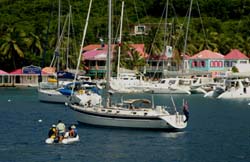 M.T. looking snappy at Soper’s Hole |
 Amanda charms the successful eye splicers – Debbie, Peter, Lore, Ross, Lynn and Stephen |
This next week will be a busy one as we will aim for four coats of varnish and a serious tidy-up of MT but our Leg 4 crew are leaving us as friends and were all happy that we have completed a successful expedition. This evening at dinner our crew were sad the expedition was at an end but all are energized with new direction for continued cruising adventures. Peter and Debbie are on their way to Fort Lauderdale and plan to purchase a boat in the next five days, Lore will continue her endeavors of single handed sailing aboard little Orion in the Balitc, Lynn and Steven thank us for enlighten them on how to sail and maintain their new Outbound 44 and Ross is now down to a short list of cruising boats suitable for his plans.


